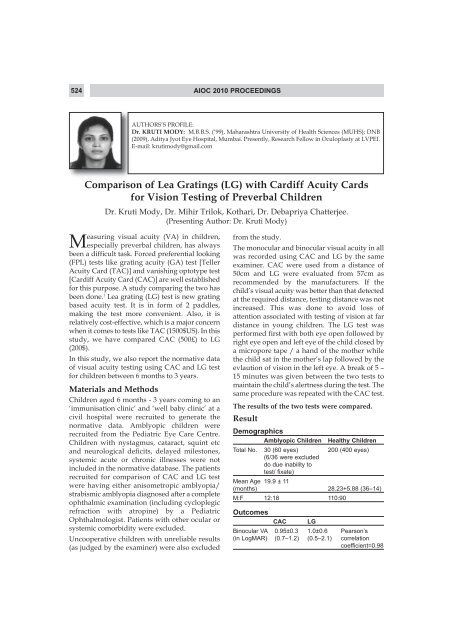Comparison of Lea Gratings (LG) with Cardiff Acuity Cards for Vision ...
Comparison of Lea Gratings (LG) with Cardiff Acuity Cards for Vision ...
Comparison of Lea Gratings (LG) with Cardiff Acuity Cards for Vision ...
You also want an ePaper? Increase the reach of your titles
YUMPU automatically turns print PDFs into web optimized ePapers that Google loves.
524 AIOC 2010 PROCEEDINGS<br />
AUTHORS’S PROFILE:<br />
Dr. KRUTI MODY: M.B.B.S. (‘99), Maharashtra University <strong>of</strong> Health Sciences (MUHS); DNB<br />
(2009), Aditya Jyot Eye Hospital, Mumbai. Presently, Research Fellow in Oculoplasty at LVPEI.<br />
E-mail: krutimody@gmail.com<br />
<strong>Comparison</strong> <strong>of</strong> <strong>Lea</strong> <strong>Gratings</strong> (<strong>LG</strong>) <strong>with</strong> <strong>Cardiff</strong> <strong>Acuity</strong> <strong>Cards</strong><br />
<strong>for</strong> <strong>Vision</strong> Testing <strong>of</strong> Preverbal Children<br />
Dr. Kruti Mody, Dr. Mihir Trilok, Kothari, Dr. Debapriya Chatterjee.<br />
(Presenting Author: Dr. Kruti Mody)<br />
Measuring visual acuity (VA) in children,<br />
especially preverbal children, has always<br />
been a difficult task. Forced preferential looking<br />
(FPL) tests like grating acuity (GA) test [Teller<br />
<strong>Acuity</strong> Card (TAC)] and vanishing optotype test<br />
[<strong>Cardiff</strong> <strong>Acuity</strong> Card (CAC)] are well established<br />
<strong>for</strong> this purpose. A study comparing the two has<br />
been done. 1 <strong>Lea</strong> grating (<strong>LG</strong>) test is new grating<br />
based acuity test. It is in <strong>for</strong>m <strong>of</strong> 2 paddles,<br />
making the test more convenient. Also, it is<br />
relatively cost-effective, which is a major concern<br />
when it comes to tests like TAC (1500$US). In this<br />
study, we have compared CAC (500£) to <strong>LG</strong><br />
(200$).<br />
In this study, we also report the normative data<br />
<strong>of</strong> visual acuity testing using CAC and <strong>LG</strong> test<br />
<strong>for</strong> children between 6 months to 3 years.<br />
Materials and Methods<br />
Children aged 6 months - 3 years coming to an<br />
‘immunisation clinic’ and ‘well baby clinic’ at a<br />
civil hospital were recruited to generate the<br />
normative data. Amblyopic children were<br />
recruited from the Pediatric Eye Care Centre.<br />
Children <strong>with</strong> nystagmus, cataract, squint etc<br />
and neurological deficits, delayed milestones,<br />
systemic acute or chronic illnesses were not<br />
included in the normative database. The patients<br />
recruited <strong>for</strong> comparison <strong>of</strong> CAC and <strong>LG</strong> test<br />
were having either anisometropic amblyopia/<br />
strabismic amblyopia diagnosed after a complete<br />
ophthalmic examination (including cycloplegic<br />
refraction <strong>with</strong> atropine) by a Pediatric<br />
Ophthalmologist. Patients <strong>with</strong> other ocular or<br />
systemic comorbidity were excluded.<br />
Uncooperative children <strong>with</strong> unreliable results<br />
(as judged by the examiner) were also excluded<br />
from the study.<br />
The monocular and binocular visual acuity in all<br />
was recorded using CAC and <strong>LG</strong> by the same<br />
examiner. CAC were used from a distance <strong>of</strong><br />
50cm and <strong>LG</strong> were evaluated from 57cm as<br />
recommended by the manufacturers. If the<br />
child’s visual acuity was better than that detected<br />
at the required distance, testing distance was not<br />
increased. This was done to avoid loss <strong>of</strong><br />
attention associated <strong>with</strong> testing <strong>of</strong> vision at far<br />
distance in young children. The <strong>LG</strong> test was<br />
per<strong>for</strong>med first <strong>with</strong> both eye open followed by<br />
right eye open and left eye <strong>of</strong> the child closed by<br />
a micropore tape / a hand <strong>of</strong> the mother while<br />
the child sat in the mother’s lap followed by the<br />
evlaution <strong>of</strong> vision in the left eye. A break <strong>of</strong> 5 –<br />
15 minutes was given between the two tests to<br />
maintain the child’s alertness during the test. The<br />
same procedure was repeated <strong>with</strong> the CAC test.<br />
The results <strong>of</strong> the two tests were compared.<br />
Result<br />
Demographics<br />
Amblyopic Children Healthy Children<br />
Total No. 30 (60 eyes) 200 (400 eyes)<br />
(6/36 were excluded<br />
do due inability to<br />
test/ fixate)<br />
Mean Age 19.9 ± 11<br />
(months) 28.23+5.88 (36–14)<br />
M:F 12:18 110:90<br />
Outcomes<br />
CAC <strong>LG</strong><br />
Binocular VA 0.95±0.3 1.0±0.6 Pearson’s<br />
(in LogMAR) (0.7–1.2) (0.5–2.1) correlation<br />
coefficient=0.98
PEDIATRIC OPHTHALMOLOGY SESSION<br />
525<br />
Monocular VA 1.32±0.08 1.15± 0.15 Pearson’s<br />
(in LogMAR) (0.2–0.6) (0.8 –1.48) correlation<br />
coefficient=0.63<br />
Time taken to 31.59+5.05 23.11±4.61 p = 0.0008<br />
per<strong>for</strong>m test (25–65) (20–50)<br />
(secs.)<br />
Discussion<br />
Our study shows that both the tests were useful<br />
in assessment <strong>of</strong> VA in preverbal children above<br />
6 months <strong>of</strong> age. We agree to the previous<br />
authors that CAC is more suitable <strong>for</strong> children<br />
above 12 months <strong>of</strong> age.2 <strong>LG</strong> is more suitable <strong>for</strong><br />

















